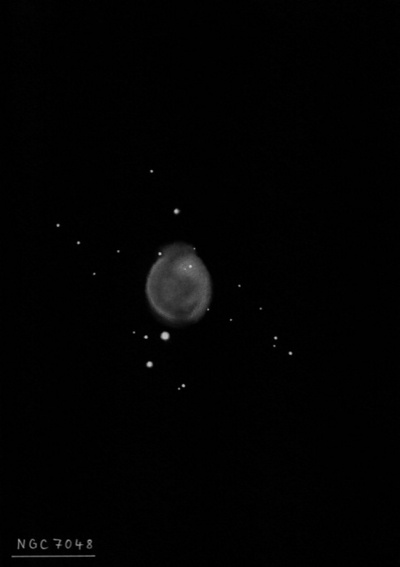
Édouard Stephan discovered NGC 7048 = St IX-28 on 19 Oct 1878. His micrometric position is very accurate. At +46° declination, NGC 7048 is the most northerly object discovered by Stephan at Marseilles as he only searched up to the zenith.
In 1919, Heber Curtis reported it was undoubtedly a planetary nebula based on a Crossley photograph and described it as "A rather faint oval, with slight traces of ring structure. It is about 60" x 50" in p.a. 20°±. The brightest portions are at the east end of the minor axis. There is a very faint central star." In 1920, Francis Pease reported it was "a planetary resembling the Dumb-bell nebula, about 1' diameter, weak axis in p.a. 170°. The central star is very faint."
400/500mm - 17.5" (8/7/91): bright, fairly large, slightly elongated N-S. Extends between a mag 10.5 star just off the south end (46" from the center) and a mag 13 star off the north end (1.0' from center). Extremely faint stars are superimposed at the west and NNE edge. Appears slightly brighter along the west and east side of the disc and the planetary has a slightly darker center (weakly annular). No central star was visible. Located 3.3' ENE of mag 8 SAO 50601.
600/800mm - 24" (8/30/16): at 376x unfiltered; fairly bright, moderately large, very slightly elongated N-S, seen full size at ~60" diameter. The rim is slightly brighter along and the western side and very weakly enhanced on the eastern edge. On the northwest side is a brighter, circular region with a faint (interior) star embedded. Overall the planetary has a very weak annular appearance. A mag 8.3 star is 3.3' WSW, a mag 10.5 star is off the SSE edge [42" from center] and a faint star is barely off the NE edge [30" from center].
900/1200mm - 48" (10/27/16): at 375x (unfiiltered); bright, fairly large, nearly round, irregular surface brightness. The rim is slightly brighter along the west and northwest side in a thin strip and very weakly enhanced on the east edge. A bright mag 10.5 star is just off the SSE edge and a mag 15.7 star is very near the NNW edge (180° opposite the bright star). There is one brighter interior star on the northwest side [17" from center]. In addition a couple of very faint stars are superimposed.
Notes by Steve Gottlieb